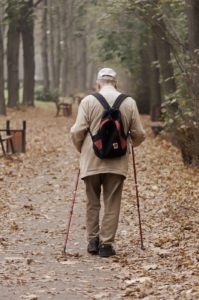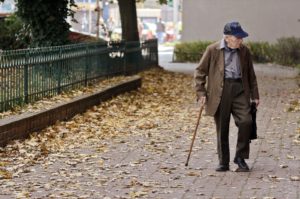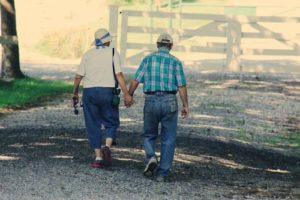Walking and Stroke Recovery: What You Need to Know
NeuroRehab Team
Saturday, January 25th, 2020
Electrical StimulationFoot Drop BraceLegMobilityNeuroplasticity

A stroke can impact any number of life skills. But the ability to walk can be one of the most significant. Many people identify walking as an important goal after they experience a stroke. This makes sense because walking is related to so many daily routines. Every stroke survivor is different. Some stroke survivors might need help to walk a few feet. Other individuals might recover significantly and be able to walk long distances. This article will provide post-stroke walking education for a range of skill levels.
It doesn’t matter how big or small your goal. Maybe you want to double your walking distance from four feet to eight feet. Or, maybe a stroke was a wake-up call to begin a healthier lifestyle which includes walking for exercise. The good news — walking is a great way to continue to move, be independent and improve your quality of life after a stroke.
Walking is a great form of exercise:
- It is low cost.
- It can be done in many different environments.
- It can be modified to fit a range of ability levels
The Benefits of Walking after a Stroke
There are many compelling reasons to work on walking. Research suggests that exercise helps improve speed, balance, confidence and cognition after a stroke. A walking program in the community showed improvement in both quality of life and endurance in stroke survivors.
Health Benefits
Some health benefits of walking include increased strength and endurance. Along with a resistance program, walking can help strengthen your legs. Improved strength and endurance can make it easier to do everyday things. Stroke survivors who exercise show a decreased risk for health problems including heart disease, future stroke, bone fractures and falls
Psychological Benefits
Walking is a great way to lift your spirits. It is not uncommon to experience depression after a stroke. A great way to reduce depression is to start moving. You can even make your walk more enjoyable by sharing a walk with another person, spending time outdoors, or giving yourself a reward for completing your walk.
Social Benefits
Improved walking ability makes it easier to get out and be with other people. You can also feel more connected with others if you find someone to join you for your walk.
Increased Confidence
The more you practice, the more confidence with walking you will experience. As you grow more confident with walking, you will also be more confident with other daily activities such as dressing, cooking or going to the grocery store.
Improved Cognition
Changes in cognition are a common concern following a stroke. A stroke can impact memory, problem-solving, and concentration. The encouraging news is, physical exercise such as walking can help improve cognition.
Difference Makers for Learning to Walk after Stroke: Rehabilitation Professionals and Assistive Devices
Physical therapy after a stroke can be vital for maximizing walking ability. Physical therapists are experts on gait, strengthening, balance, and stretching. In an initial assessment, a physical therapist can identify what problems are impacting your ability to walk. Then, they will help you develop and complete a program to address these areas.
One study looked at improvements in walking based on the number of physical therapy sessions. This study found that people improved their speed of walking and the distance they were able to walk. The most significant improvements were seen in the first 24 sessions and improvement continued up to 36 sessions.

Assistive devices provide support and safety as you learn to walk after a stroke. A physical therapist can help you select a device that meets your needs. They can also help make sure it is correctly adjusted.
A physical therapist can work with you to decide when to transition to a device with less support. For instance, you might start walking with a walker. Then you may progress to a cane as your strength and balance improve.
Electrical stimulation devices are another tool that can be helpful for walking recovery after stroke. Electrical stimulation devices uses electrical current to activate muscles. This can help strengthen muscles or get them to fire more independently. There are a variety of electrical stimulation options.
You can learn more about different units and compare them at NeuroRehab Directory.
When learning to walk after a stroke, it is helpful to understand the multiple skills that are required for this complex tasks. Walking requires leg strength, balance, endurance, visual-perceptual skills and core strength. Every person is different. The skills and the amount of recovery for each stroke survivor can vary.
Leg Weakness
A common symptom after a stroke is weakness on one side of the body. The weakness in the leg can range from mild weakness to complete loss of muscle control in the leg. To return to walking after stroke, you will need to address the strength in the affected leg.
The first goal is to get strong enough for your leg to support your weight when standing. Ongoing strengthening is important because leg strengthening programs can help increase walking speed for older adults.
Hemiplegia is when one side of the body is paralyzed after a stroke. As the brain heals and forms new connections, some symptoms of hemiplegia may resolve. Other people with significant hemiplegia may have a limited return of muscle control on that side of the body. This can make it difficult to return to walking.
Foot drop is another symptom of weakness after a stroke. Foot drop is when the muscles that lift the foot don’t work well. This makes it hard to properly walk because you need to lift the toes to complete a walking motion. Braces such as an ankle-foot orthosis (AFO) can assist in holding the foot in a better position so you will not trip on your toes while walking.
Learn more about AFO’s for foot-drop at NeuroRehab Directory.
Balance
It is important to not only have the strength to walk but also the balance to prevent falls. A key part of balance is your brain understanding where your body is in space. This enables you to make balance corrections to prevent falling.
Balance is a combination of inner ear sensation, body feedback, and ability to fire the muscles quickly for corrections. Balance allows you to stand upright when turning your head or body. It also allows you to make adjustments when walking on gravel or grass.
Click here to learn more about Balance treatment ideas.
Toe-Curling or Claw Toe
Toe-curling or claw toe can make it more difficult to walk after a stroke. The toes can feel tight and curl. This can make it uncomfortable to walk or more difficult to find a well-fitted shoe. Toe-curling is the result of a muscle imbalance in the feet following a stroke.
Common ways to improve toe-curling include:
- Exercises to improve the muscle imbalance. Click here for a recommended toe exerciser.
- Stretching the muscles of the feet. Click here for a recommended foot stretching device.
- Shoes with extra room.
- Orthotics to help improve toe alignment.
Visual and Perceptual Changes
Vision changes after a stroke may also impact a person’s ability to walk. This may make it difficult to see to navigate while walking. Changes in vision can also impact balance.
Hemi-neglect is when the brain doesn’t do a good job of processing information on one side of the body. This could be sound, sight or touch. This makes it more difficult to walk because the brain forgets to monitor that side of the body. This can lead to bumping into objects or doorways when walking.
Visual field deficit is when the brain doesn’t process the vision from one side. This means that the person is seeing the world through a smaller arc of vision. Again, this can make it difficult to see objects when walking. People with this condition can be trained to turn their head or to increase the movement of their eyes to see the missing area.
Core Strength
The foundation of movement of the legs and arms is the core or the abdomen. To hold yourself upright for walking, you will need a strong core. Addressing the trunk early in a rehabilitation program can improve later walking and balance.
General Exercise Guidelines
Selecting the right intensity for an exercise or walking program is important. You want your program to be challenging enough to make improvements, but not so challenging that it causes injury or exhaustion.
A general rule is to start slow and build. If you can walk across the room easily, add a little more so that you are walking across the room two times. If you are walking out to your mailbox, walk to your mailbox and then add 10 feet down the sidewalk.
Consistency is also important. It is better to walk a little each day instead of trying to do a whole bunch once a week. Take into consideration the time of day where you feel your best. Do you have the most energy in the morning? Or, are you the most energetic mid-afternoon? Take advantage of your “good time” of day to work on your walking.
Tips to Promote Safety When Walking After Stroke
It is important to take safety into consideration when learning to walk after a stroke. You want to make consistent progress and don’t want a fall to cause any setbacks. Remember it takes time for your body and brain to heal so it is important to be a little extra careful.
Safe Places to Walk
Find safe places for walking that match your skill level. Start with walking indoors on level surfaces. Especially if you are only able to walk a few steps or have impaired balance. Pick somewhere you can sit if needed. When walking in your home, reduce trip hazards by clearing pathways of clutter or throw rugs.
After you have mastered short distances, consider new places with more space for walking. Can you make a longer circuit in your home? What about walking in a store or out to your mailbox using the sidewalk.
New challenges and opportunities are available as you progress to working on distance and balance. You can walk down the sidewalk — making sure to look for cracks or unlevel areas. You could also consider walking at an indoor track or at an indoor mall. Remember to continue to pay attention when walking on unlevel surfaces such as grass, gravel, ice/snow and thick carpeting.
Find a Walking Buddy

It is also a good idea to walk with someone else. Initially, this might be a skilled professional such as a physical therapist or a nurse aide. Remember to follow their instructions on when you can start walking with a family member or on your own. In the early stages of recovery, another person might be helpful for many reasons. You may get tired quickly, or need someone to steady your balance or scan for possible obstacles.
It can still be helpful to have someone join you for longer walks in case something happens. Plus, it is nice to have a walking buddy to improve accountability, make it more fun, and maximize safety. If you don’t have someone to walk with, consider how you would get help if an emergency were to occur. For this situation, items like a medical alert bracelet and a cell phone might be beneficial.
Use the Right Gear for Walking
Make sure you have appropriate supplies for walking. If you need an assistive device such as a cane or walker, make sure you use it. Especially if you are challenging your endurance by going on longer walks. Wear supportive walking shoes with good soles. When walking outside, wear clothing that is appropriate for the weather. Also, remember to stay hydrated as walking is a form of exercise.
Walk Your Way to Wellness, One Step at a Time
Big results can occur when you do a little at a time. You can improve your walking ability, one day, one skill, and one walk at a time. Whether you are looking to improve safety, balance, speed, endurance, or your mood — exercise by walking can be beneficial. Consider how you might challenge yourself, be safe, and be successful.
References
- Gordon, C.D., Wilks, R., McCaw-Binns (2013). Effect of Aerobic Exercise (Walking) on Functional Status and Health-related Quality of Life in Chronic Stroke Survivors. Stroke, 44(4), 1179-1181. https://www.ahajournals.org/doi/10.1161/STROKEAHA.111.000642
- Saunders, D. H., Creig, C.A., Mead, G.E (2014). Physical Activity and Exercise after Stroke: Review of Multiple Meaningful Benefits. Stroke, 45(12), 3742-3747. https://www.ahajournals.org/doi/10.1161/strokeaha.114.004311.
- Saunders DH, Sanderson M, Hayes S, Kilrane M, Greig CA, Brazzelli M, Mead GE. Physical fitness training for stroke patients. Cochrane Database of Systematic Reviews 2016, Issue 3. Retrieved from https://www.cochranelibrary.com/cdsr/doi/10.1002/14651858.CD003316.pub6/full
- Cumming, T., Tyedin, K., Churilov, L., Morris, M., & Bernhardt, J. (2012). The effect of physical activity on cognitive function after stroke: A systematic review. International Psychogeriatrics, 24(4), 557-567. Retrieved from https://www.cambridge.org/core/journals/international-psychogeriatrics/article/effect-of-physical-activity-on-cognitive-function-after-stroke-a-systematic-review/462AFECA530E9E26D0360294A2059DF8
- Rose, D. K., Nadeau, S. E., Wu, S. S., Tilson, J. K., Dobkin, B. H., Pei, Q., & Duncan, P. W. (2017). Locomotor Training and Strength and Balance Exercises for Walking Recovery After Stroke: Response to Number of Training Sessions. Physical therapy, 97(11), 1066–1074. doi:10.1093/ptj/pzx079 Retrieved from https://www.ncbi.nlm.nih.gov/pmc/articles/PMC6075074/
- Mehrholz, J., Thomas, S., Werner, C., Kugler, J., Pohl, M., & Elsner, B. (2017). Electromechanical-assisted training for walking after stroke. The Cochrane database of systematic reviews, 5(5), retrieved from https://www.ncbi.nlm.nih.gov/pmc/articles/PMC6481755/
- Van Abbema, R., De Greef, M., Crajé, C., Krijnen, W., Hobbelen, H., & Van Der Schans, C. (2015). What type, or combination of exercise can improve preferred gait speed in older adults? A meta-analysis. BMC geriatrics, 15, 72. Retrieved from https://www.ncbi.nlm.nih.gov/pmc/articles/PMC4488060/
- Sorinola, I.O., Powis, I., White, C.M. (2014). Does additional exercise improve trunk functional recovery in stroke patients? A meta-analysis. NeuroRehabilitation, 35(2), 205-213, Retrieved from https://www.ncbi.nlm.nih.gov/pubmed/24990030.


Leave a Reply
You must be logged in to post a comment.